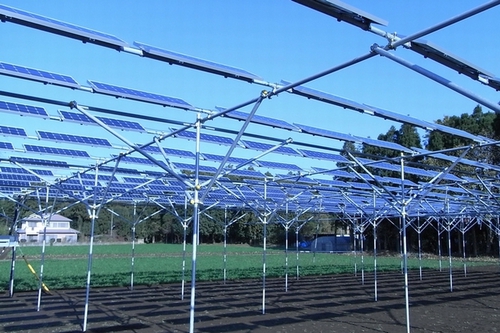January 14, 2014
Balancing Energy and Crop Production through Solar Sharing
Keywords: Food NGO / Citizen Renewable Energy
The Solar Sharing Association began to operate the Solar Sharing Hayashi Power Station in November 2013 in Chiba City, Japan. Installing solar panels above farmland, the association is attempting to generate power while cultivating crops, and strives to promote solar sharing systems by holding study excursions and other activities.
At the Hayashi Power Station, mounting-poles were erected in one area of the farmland (about 645 square meters), and 272 small solar panels with an output of 90 watts each were installed 3.5 meters above the ground. The station's total installed capacity is about 25 kilowatts, and the income from selling the electricity under the feed-in-tariff scheme is estimated at about 1.05 million yen (about U.S.$10,700) per year. Its initial cost is expected to be paid off within seven years.
After the Ministry of Agriculture, Forestry and Fisheries of Japan approved the installation of photovoltaic generation systems in farmland in April 2013, the introduction of solar sharing has advanced across the country. The Ministry's guidelines require the system installation does not disturb the farming, through implementation of measures such as securing the amount of sunlight needed for crop growth, occupying the minimum area possible for the system, and installing easy-to-remove structures.
The Solar Sharing Association aims to promote the well-planned spread of solar sharing, including the appropriate installation of systems. Mr. Michio Sakamoto, director of the association, enthusiastically says, "we want to practice solar-powered agriculture by effectively using electricity generated photovoltaically as a power source for operating agricultural machinery and automated watering apparatuses."
Written by Kazuko Kojima
Related
"JFS Newsletter"
- 'Yumekaze' Wind Turbine Project Connects Metro Consumers and Regional Producers: Seikatsu Club Consumers' Co-operative
- Shaping Japan's Energy toward 2050 Participating in the Round Table for Studying Energy Situations
- Nishiawakura's Initiative for 100% Energy Self-Sufficiency, and a Municipal ICO Scheme
- Actions Toward 100% Renewable Energy in Japan
- Sustainable Community Building in Shimokawa: Recycling-Oriented Forest Management Enabling Permanent Use of Forest Resources
Related
"Popular Articles"
- Current Status of Renewable Energy in Japan (2015)
- Offshore Wind Farm Withstands Great East Japan Earthquake and Tsunami
- Current Status of Renewable Energy in Japan (2014)
- Geothermal Power: Japan Has World's Third Largest Geothermal Reserves, 60 Percent of Which Can Be Developed
- Tokyo Plans to Increase Renewable Energy Ratio to 20% by 2024



